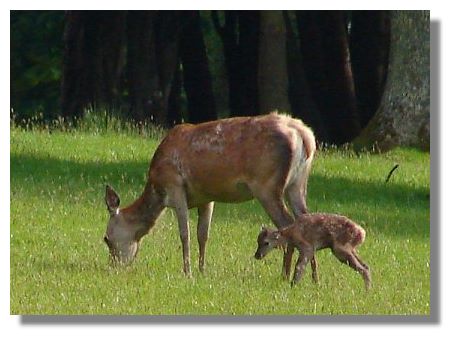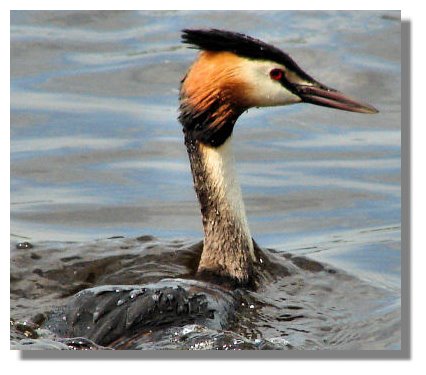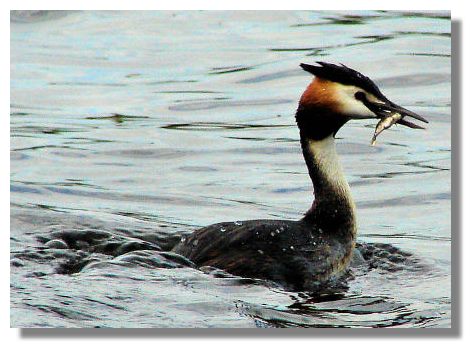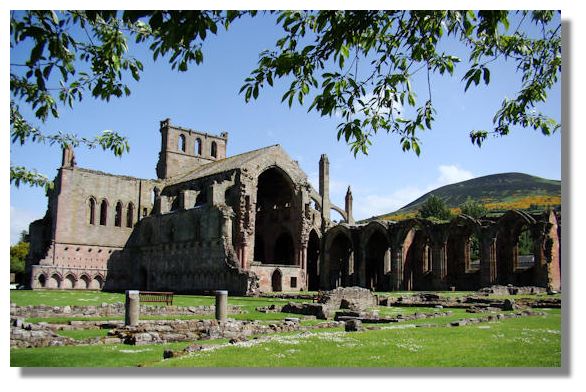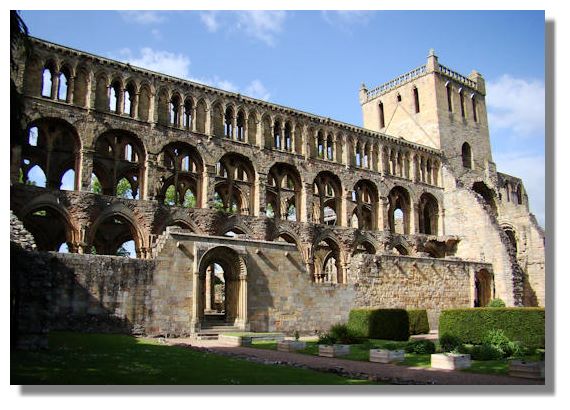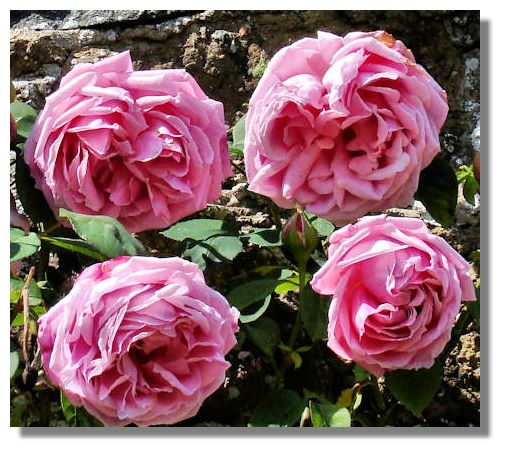The Iris is named after the Greek goddess of the rainbow and they certainly come in a rich range of exquisite colours. The sun was shining from behind these plants, adding to the brightness of the white petals.
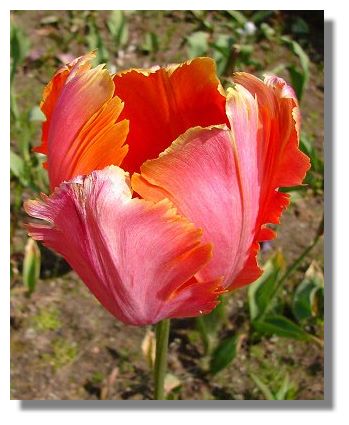
Tulips are all but over by this time in June, but the fringed varieties, such as this one at Culzean Castle walled garden, are amongst the later-flowering kind.
The unsteady-looking young deer had been born only shortly before this photo was taken at Culzean Castle Country Park. It was still at the staggery stage when we first saw it, but a few visits to the "milk bar" and licks from mum soon got it going. It was doing a few skips by the time we dragged ourselves away. Mum was most unconcerned and continued to munch the grass most of the time. One of the staff commented (with a hint of justifiable pride) that it was the 10th calf this year - the National Trust for Scotland maintains a medium-sized herd of red deer in the country park.

Although there were a number of butterflies to be seen in the walled garden at Culzean Castle, they were too busy flying around to stop long enough for a picture! Even this Red Admiral refused to spread its wings and allow a picture of its more colourful upper wings. Still, the camouflage pattern seen here has its own attractiveness.
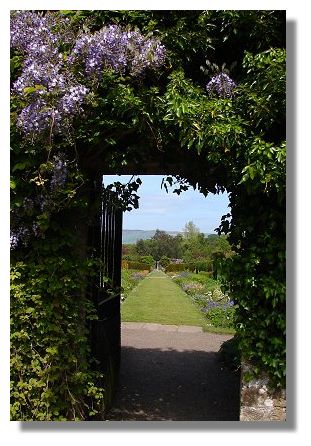
Initially, I was taking this picture of the Wisteria flowers trailing down the wall but I soon realised that through the gate, it also gave a good impression of the long - very long - herbaceous border within the walled garden. The border is at its best in July and August but even so there were plenty of different varieties of Aquilegia and Geraniums to add a splash of interest and colour at this time of year.
Oystercatchers always look a bit incongruous with their out-of-proportion orange beak, strutting walk and strident alarm call. They look even more out of place in the countryside, far away from any oysters to catch - though many of them take up residence there. Their nest is usually just a depression on the ground - but the parents will attack anything that comes close - sheep will get a nip on the leg, for example. The tactics seem to have paid off for this pair of Oystercatchers as they had two chicks running around, looking a bit lost. Young Oystercatchers don't feed themselves and depend on their parents until they fly, about four weeks after they hatch.
The Great Crested Grebe is normally a very shy bird, so getting close to them to get a sharp picture is often very difficult. On this occasion, the bird was near the shore of a small loch at Drumpellier Country Park. Even though it started to head away, I was able to get this clear shot.
Surprisingly, after a successful under-water dive to catch a fish, the Grebe re-appeared, close in shore. The Grebe may have been saying "Gotcha" - but so was I...
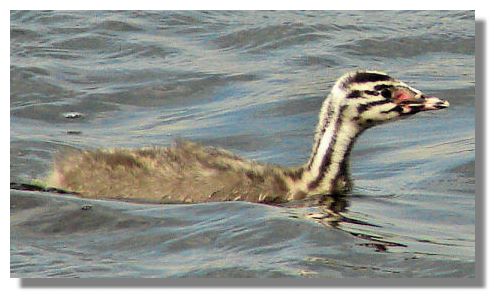
The reason for the Grebe being more intent on catching fish rather than steering clear of any potential danger, soon became clear when its chicks came rushing across the water. Many young birds noisily make their presence known to encourage their parents to bring them food. But the baby Grebes must be the loudest around - they can be heard far across the loch.


Culzean Castle Country Park has a number of small, secluded ponds where damselflies and dragonflies can often be seen at this time of year. Seen close up, these insects sometimes look a bit "scary" but their coloured markings can often be very attractive. The picture on the left (on most browsers) is a female Variable Damselfly. It is not often found in Scotland, but is quite widespread in Ireland and this one may have been blown across the North Channel to Culzean in south-west Scotland. The second dragonfly on the right is a male "Common Blue" which, as the name suggests, is often to be seen in Scotland and the rest of the UK.
A monastery at Old Melrose, to the east of the present town of Melrose, was established around 650AD. But it was King David I who invited Cistercian monks in 1136 to rebuild the abbey (the original had been destroyed by Kenneth MacAlpin 200 years earlier) but they decided to create a new building at Little Fordell (now Melrose). It eventually became one of Scotland's wealthiest medieval monasteries. But the peace of the abbey was shattered in 1296 with the invasion of Scotland by King Edward I of England and again in 1322 when Edward II sacked the building. Robert the Bruce assisted in the rebuilding of the abbey and his heart was buried there.
The viewing platform at the top of Melrose Abbey givea a fine view of the Eildon Hills - encircled by yellow gorse at this time of year. It was Sir Walter who wrote that it was Michael Scott "the Wizard" who "cleft the Eildon hills in three and bridled the river Tweed with a curb of stone". Michael Scott was an important philosopher at the Court of the Holy Roman Emperor, whose writings and translations were valued around Europe in the 13th century. His involvement in alchemy, astrology and astronomy gave him a reputation for being a "wizard" which entered the mythology of Scotland, particularly in the Border area. Sir Walter Scott enhanced his reputation when he wrote about him in his ballad "The Lay of the Last Minstrel". Sir Walter describes in graphic detail in his poem that Michael Scott and his book of wizardry were buried "on a night of woe and dread" in Melrose Abbey - and who would dare argue?
King David I founded the Augustinian priory of Jedburgh on the banks of the Jed Water in 1138 (or possibly earlier) to demonstrate to his own subjects - and to those in England - that he could create a magnificent building in the southernmost part of his kingdom. It took over 100 years to complete the abbey but shortly after, the devastation of the "Wars of Independence" swept through the Borders (and beyond) as King Edward I and his successors regarded destroying castles and abbeys alike as ways of demonstrating who was in charge. Jedburgh was badly damaged and rebuilt several times but the final crunch came in the 1540s when King Henry VIII demanded that his son, the future Edward VI of England (aged 10) should marry Mary Queen of Scots (then aged 5) - a time known as the "Rough Wooing". Soon after that, Scotland went through a period of religious reformation which saw an end of the dominance of the Roman Catholic Church - with all its symbols, including abbeys and monasteries. So Jedburgh and many other similar buildings were never rebuilt.
There is a small garden next to Melrose Abbey (not much there at this time of year though) and the walls enclosing the abbey grounds have lots of climbing plants on them, including some magnificent rambling roses. This quartette all came into flower at the same time to create this striking montage.
"Sweet William" (Dianthus barbatus and also nicknamed as "Indian Carpet") comes in many different colours and the walled garden at Culzean had a number of them on display this year. The plant is said to have got its name from the Duke of Cumberland (Butcher Cumberland to the Jacobites, after their harsh treatment after the uprising in 1745/46). As a result, it is sometimes known in Scotland as "Stinking Billy".If you want to look back at other editions of these photos of Scotland week by week, there is an Index Page

